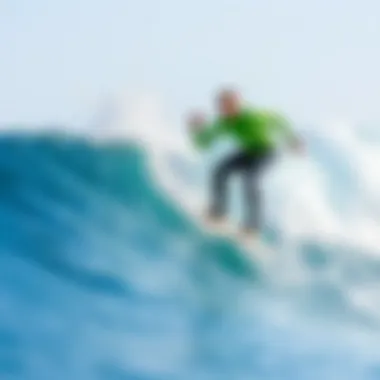Affordable Bodyboards for Surfing Enthusiasts


Intro
Bodyboarding offers a rush that few other water sports can compete with. The thrill of catching a wave, the splash of seawater, and the sense of freedom are integral to the experience. However, many beginners and even seasoned surfers might hesitate when faced with the price tags on some high-end bodyboards. The truth is, great riding experiences don't necessarily come at a high cost.
This article digs deep into budget-friendly bodyboards that strike a balance between quality and affordability. With the right bodyboard, you can enjoy the waves without emptying your pockets. We'll explore vital factors like construction materials, shape, and performance attributes while sharing recommendations from users who have ridden these boards in various conditions.
Whether you're just starting out or looking to upgrade, understanding what to look for in a bodyboard can make all the difference. So, let’s catch this wave together and discover the best budget options available for surf enthusiasts of all levels.
Surfing Techniques
Mastering the Basics
Before plunging into the world of bodyboarding, it’s crucial to get the basics right. Newcomers should start on soft-top boards, which provide a stable platform for learning. The key lies in understanding your body position, paddling efficiently, and timing your wave take-offs.
Proper body position is akin to finding your sweet spot in the water—lay too far back, and you'll miss the wave; too far forward, and you might dive underwater, much like a stone skipping the surface.
Here are a few tips:
- Paddle Power: Train your upper body for paddling, as strength and stamina will enhance your wave-catching ability.
- Choose the Right Wave: Not every wave is suitable for beginners. Look for smaller, unbroken waves to start.
- Kick with Purpose: When you catch a wave, kick with your legs to maintain speed and balance. This can feel a bit like catapulting into a ride that propels you forward.
Advanced Maneuvers
Once you've got the basics down, it’s time to hone your skills. Advanced maneuvers can elevate your bodyboarding experience, making it more dynamic. These techniques might require practice, but they add remarkable flair to your performance.
- The Drop Knee: This technique involves dropping one knee onto the board while keeping the other foot planted.
- 360 Spins: This is where the fun begins. Using your hips and shoulders, create a rotational movement that sends you spinning.
- Air Moves: Pulling tricks off the lip can give you an exhilarating feeling—though, it also requires precision and control.
Above all, practicing these moves takes patience and determination, much like learning to walk before you run.
Surfing Lifestyle
Sustainable Surfing Practices
As much as bodyboarding is about riding the waves, there’s a growing shift towards sustainability in the surf community. Opting for eco-friendly boards can significantly lessen your environmental footprint. For example, boards made from recycled materials or those that are biodegradable show a commitment to keeping our oceans clean.
Supporting brands that prioritize environmentally-friendly practices helps weave sustainability into the fabric of surfing. The ocean is our playground, and it’s only right we take measures to protect it.
Surf Culture Around the World
Surfing culture is as diverse as the locations where it's practiced. From the shores of Hawaii to the coastlines of Australia, each area brings its own flavor to the sport. International bodyboarding competitions attract participants eager to showcase their skills. Events like the IBA World Tour illustrate this diversity, with surfers from different cultures sharing stories, techniques, and experiences.
This rich tapestry of backgrounds enhances the awareness of the sport and creates a sense of community among surfers—reminding us that while we’re all riding different boards, we share the same waves.
"Surfing's not just a sport, it's a way of life that transcends borders."
When selecting a bodyboard, consider your style, budget, and the environment you plan to ride in. It’s not just about the wave; it’s about how you connect with it.


For additional details about surfing materials and practices, visit resources like Britannica or threads on Reddit.
As we move forward in this guide, we'll outline specific bodyboard models that fit various styles and performance needs without compromising on quality. Let's get into the nitty-gritty and discover your next favorite ride.
Intro to Bodyboarding
Bodyboarding is more than just a water sport; it’s an experience that intertwines rider and wave in a dance of agility and creativity. This article explores the multifaceted world of budget bodyboards, catering specifically to surf enthusiasts, whether they're just starting their journey or are seasoned veterans looking for economical yet reliable options.
Understanding bodyboarding begins with recognizing its appeal across various demographics. For some, it’s a casual day at the beach enjoying the waves; for others, it’s a competitive pursuit pushing the limits of skill and technique. Being able to choose the right bodyboard at a budget-friendly price can make all the difference.
Effective bodyboarding requires the appropriate equipment, notably a well-constructed board that offers both durability and enhanced performance. The right board accommodates different surfing styles, conditions, and personal preferences. Moreover, budget does not equate to low quality. There are numerous economical options available that do not compromise on performance.
Historical Context
Bodyboarding might not have the same historical gravitas as traditional surfing, but its roots run deep in beach culture. Originating in the 1970s, the sport has grown through various cultural adaptations and innovations. What began as a simple, foam core board on tropical beaches has evolved into a dynamic sport with international appeal. Understanding this context helps enthusiasts appreciate the evolution of equipment and its impact on performance.
Notably, early bodyboards were typically crafted from simple materials, leaving plenty of room for improvement and innovation. Various manufacturers began to invest in better foam and tail designs, improving the experience for riders of all levels. As time passed, bodyboarding transitioned from small local beaches to competitive arenas, highlighting the sport's potential and attracting a wider audience.
Bodyboarding vs. Surfboarding
At first glance, bodyboarding and surfboarding may appear similar, but they each offer unique riding experiences. The main distinction lies in the position of the rider. For bodyboarders, it’s about lying flat on the board or kneeling, which can allow for quick maneuvers and agile turns. In contrast, surfers stand upright, which demands a different balance and technique.
From a materials perspective, bodyboards often use softer foam compared to the rigid constructions of surfboards, making them more user-friendly for beginners. Additionally, bodyboards can be ridden in smaller waves, which is ideal for those who may not have access to big swells. The aspect of maneuverability is another highlight, as bodyboards are generally more adaptable in choppy conditions than traditional surfboards.
Understanding Bodyboards
Understanding bodyboards is crucial for anyone interested in maximizing their surfing experience, especially when on a budget. Bodyboards are more than just pieces of foam; they are carefully crafted equipment specifically designed to adapt to the diverse elements of the ocean. It’s important to recognize that the ideal bodyboard doesn’t necessarily mean the most expensive one. Rather, it’s about finding a board that aligns with one's individual surfing style, skill level, and surf conditions. This exploration of bodyboards is intended to help aficionados, whether they are beginners or seasoned riders, make informed choices about what suits them best.
Construction Materials
The construction materials of a bodyboard play a pivotal role in its performance. Different materials impart various characteristics that can significantly affect a user’s experience, thereby making the choice more complex than it seems at first glance.
Soft top vs. hard top
Let’s think about soft tops versus hard tops. A soft top bodyboard is primarily designed with a softer foam layer, making it quite forgiving for beginners who may not yet be comfortable in the water. The softness leads to an easier grip against one's body, which can enhance comfort during rides. On the flip side, hard tops tend to provide better speed and control, appealing to more experienced riders who seek performance in challenging surf conditions. The unique feature of a soft top is its added buoyancy, allowing it to stay afloat longer and making it easier to navigate through small waves. But the downside? It may sacrifice speed and durability in the face of aggressive usage or turbulent waters.
Types of foam used
Now, let's delve into types of foam used in bodyboards. Two common types are polyethylene (PE) and polypropylene (PP). Polyethylene foam is popular among beginners due to its durability and safety. It’s resistant to punctures and tends to retain its shape over time, providing a smoother ride for novices. In contrast, polypropylene is lighter and typically used in more performance-driven boards, favoring speed. One might say it's like the race car of foams. However, this type is less forgiving, often favored by those with a richer riding history who can handle the risks that come with its fragility. In both cases, understanding the foam type is crucial as it directly correlates to ride quality, stability, and overall enjoyment while bodyboarding.
Fin Systems
Fin systems may not be the first thing that comes to mind when discussing bodyboards, yet they are vital for performance. The right fin system can improve maneuverability and enhance ride control. Some bodyboards come with fins that are removable, allowing the rider to customize their setup based on conditions or personal preference. This feature appeals to those who like to adapt their bodyboard for different waves and surf styles. Other boards may have fixed fins, which can be great for stability but also limit versatility.
Factors to Consider When Buying a Budget Bodyboard
When it comes to selecting a bodyboard that fits your needs and bank account, several factors stand out that’ll assure you grab the right gear without burning a hole in your wallet. Understanding these elements will make you feel more empowered, whether you're a rookie hitting the waves or an experienced rider looking for something new. Before diving into the action, let’s break it down to ensure you know what to look for when hunting for that ideal budget bodyboard.


Size and Shape
Length considerations
The length of a bodyboard plays a pivotal role in your riding experience. Generally, the length can vary from about 40 inches to 45 inches. A shorter board usually facilitates more maneuverability, especially in tight wave conditions, making it a go-to choice for many seasoned surfers seeking quick turns. Conversely, longer boards tend to provide greater speed and stability, especially beneficial for larger waves. It’s like the Goldilocks principle: too short, and you might struggle for control; too long, and you might feel sluggish. A board that suits your height and weight is essential. For instance, a rider standing five-foot-eight might find a board around 42 inches to be just right—allowing for a balance between control and rapid pace.
Width and volume impact
Width and volume also play crucial rolse in how a bodyboard performs in the water. Wider boards offer you heaps of stability, which helps beginners find their footing—or should I say, laying position—much more easily. On the flip side, narrower boards tend to slice through the water more efficiently, helping with speed. In terms of volume, a thicker board can float a little better, which gives you some added glide on the waves. Think of it as choosing between a floaty ride and a speedy rocket. Finding that balance often comes down to your personal style and your comfort level. Therefore, if you feel more inclined to catch those gnarly left-breaks, a slightly thinner, narrower board might be your best mate.
Criteria for Performance
Speed and control
When you ride the waves, speed and control are paramount. The bodyboard's design features—like its tail shape and bottom contour—can significantly influence how well you can maneuver. A board that features a crescent tail typically offers greater control, allowing for sharper turns. If you're after speed, look for a slick bottom surface that reduces drag. Some longer, flatter boards are great for speed, but may lack that snappy response when you need to dart around. Finding that sweet spot between speed and control will make your surfing experience far more enjoyable.
Stability in different conditions
Stability can't be overstated. You're not always going to be blessed with sweet, glassy waves. Sometimes conditions can turn coarse and choppy. A stable board helps maintain control under such circumstances. Boards with a wider profile often provide enhanced stability, making it easier to stay upright and navigate through mixed wave conditions. This can be crucial for less experienced riders who might not have yet mastered taming unruly swells. Remember, it’s often better to have a slightly more stable board in rougher conditions than to risk taking a spill by choosing a board that’s purely tailored for speed.
Ultimately, a keen understanding of size, shape, performance attributes like speed and stability will help you choose an affordable bodyboard that complements your surfing potential.
Top Budget Bodyboards on the Market
The world of bodyboarding is as vast as the ocean itself, and choosing the right board without draining your wallet is essential for both beginners and veterans alike. Understanding which budget bodyboards offer the best bang for your buck ensures that you not only enjoy your time in the water but also get quality performance tailored to your skill level. Indeed, budget options can be heavy hitters in terms of design and capability, allowing enthusiasts to partake without fuss, while getting the most out of their investment.
Tailored Recommendations
Best for beginners
When stepping onto the sand for the first time, picking a bodyboard suited for beginners is crucial. A key characteristic of the best beginner boards is their stability and ease of use. For instance, the Empire S6 Bodyboard stands out due to its soft top design, providing a forgiving surface that’s friendly for those unaccustomed to the ocean's rhythm. This model allows newcomers to catch waves more easily and maintain balance, making it a popular choice.
One unique feature of the Empire S6 is its lightweight core, which not only enhances buoyancy but also makes maneuvering a breeze. A potential downside might be that while it's great for learning, the board may lack the responsiveness experienced riders demand. Still, for those just starting out, this board strikes the right balance of fun and function.
Best for experienced riders
Experienced bodyboarders usually seek boards that can handle the intensity of larger waves and more technical maneuvers. The NMD BZ3 Bodyboard is a solid contender in this category, built with a high-density foam and a slick bottom for speed. Riders often appreciate its superior grip and responsiveness, which ultimately leads to a more thrilling ride.
This model provides a unique aspect—its bat tail design, allowing sharp turns and fantastic control in dynamic surf conditions. However, it does come at a slightly higher price point within the budget range, which may lead some to reconsider if they're looking strictly for the cheapest option. Nonetheless, the performance it offers makes it a worthwhile investment for those who have honed their skills.
Best all-round options
For many surfers, finding a versatile board that meets a broad spectrum of needs is key. The Cocoa Surf Bodyboard shines here, as it combines performance and usability for varying skill levels. One notable characteristic is its slightly wider profile, making it suitable for different wave types while still being user-friendly. This adaptability makes it an appealing option for those who want to try different styles.
Among all its features, the Cocoa Surf is often lauded for its balance between price and quality, ensuring you're getting a solid board without stretching your budget too thin. On the downside, it may not excel in highly specialized conditions, but as a jack-of-all-trades, the advantages it offers are too good to pass up.


Brand Comparisons
As you consider the right board for you, comparing brands can enlighten your decision-making process. Different brands come with unique features and specifications that cater to various preferences and styles. You might want to research the customer service records, warranty options, and brand reputation when making your choice.
To get the most out of your investment, compare highlights like ride performance, durability, and design aesthetics. Seeking user reviews on sites like Reddit, or checking out discussions on Facebook groups tailored to bodyboarding can offer valuable insights directly from fellow enthusiasts.
Ultimately, when it comes to budget bodyboards, doing your homework pays off. Finding the right balance of quality, performance, and price is just a wave away.
User Reviews and Experiences
Understanding user reviews and experiences is critical in the domain of bodyboarding, especially when it comes to selecting budget-friendly options. Customer feedback offers insight beyond mere specifications, shedding light on real-world performance and durability that manufacturers’ claims often overlook. This section dives deep into the discussions and reviews provided by surfers who have put various budget bodyboards to the test, helping potential buyers make more informed decisions.
Case Studies of Popular Models
When we toss the ball into the court of consumer experiences, several bodyboards stand out among the crowds. These models have garnered attention for their reliability, performance, and affordability. Let’s look at a few poignant case studies:
- Wham-O Bodyboards
This budget board is often cited for its lightweight design and colorful aesthetics. Users appreciate its maneuverability in small to moderate surf. Many reviews highlight how it handles well for trick maneuvers, making it ideal for beginners who are eager to learn. - BPS Storm Bodyboard
Reviewers frequently note the BPS Thunder’s soft top, recommending it for younger or inexperienced riders. The added grip allows for better control, leading to confidence-building rides. Feedback shows people love the value it offers, given the price point. - Coco Mat Bodyboard
Users have had mixed feelings about the Coco Mat. While some praise its eco-friendliness, using sustainable materials, others mention durability issues over time. It shines in performance but has raised eyebrows when it comes to long-term wear.
These case studies illustrate how personal experiences with specific bodyboards can lead to a greater understanding of the product, showing both strengths and weaknesses that aren’t always evident in the store.
Common Feedback from the Community
Feedback from the bodyboarding community is a treasure trove of information. Here are some recurring themes in user comments and reviews that offer valuable insights for anyone on the hunt for a budget bodyboard:
- Value for Money: Many enthusiasts stress the importance of finding the right price-performance ratio. Often, models that are cheaper do not mean compromising on quality. Those who have tried different boards often suggest investing a bit more for durability.
- Weight Considerations: A common sentiment among riders is that a lighter board often leads to better control and ease in swift maneuvers. Generally, users recommend trying out different weights, especially when tackling different wave conditions.
- Recommendations for Beginners: Many experienced riders chime in, emphasizing the need for novices to start with softer top boards. The sensitive nature of beginner skills means having a forgiving board can aid in learning, reducing the chances of injuries.
- Durability Issues: Users frequently caution that while a board might perform well initially, certain budget models may suffer from wear and tear sooner than expected. This aspect leads to discussions around maintenance strategies, aimed at prolonging the lifespan of these boards.
As evident from user feedback, navigating the world of bodyboards can be tricky, yet vital in ensuring an enjoyable ride on the waves. Gathering insights from the community not only empowers buyers but also fosters a culture of informed decisions, ultimately enhancing enjoyment in this exhilarating sport.
Maintaining and Caring for Your Bodyboard
Taking care of your bodyboard is crucial not only for its longevity, but also for ensuring an optimal experience while riding those waves. When you invest in a budget bodyboard, keeping it in good shape pays off in the long run. Without proper maintenance, you might find that even the best boards can lose their performance, leading to a frustrating surf session. In this section, we will delve into essential cleaning and storage tips, as well as methods for repairing minor damages to keep your bodyboard riding smoothly.
Cleaning and Storage Tips
Cleaning your bodyboard might seem like a no-brainer, but many riders overlook this vital step. After each session, rinse off your board with fresh water to remove salt, sand, and other debris. Salt, in particular, can wreak havoc on the board’s surface, potentially leading to deterioration over time. If your bodyboard has been in particularly muddy waters or has absorbed the ocean's grime, using a mild soap can help ease the cleaning process.
Here are some additional tips to keep in mind:
- Drying: After you’ve cleaned your board, dry it thoroughly to eliminate moisture which can lead to mold. Lay it flat in a shaded area to avoid direct sunlight, which might warp or fade the colors.
- Storage Position: Store your bodyboard vertically or on its side rather than stacking it horizontally under weighty items. This prevents bending and retains its shape.
- Avoid Extreme Temperatures: Do not leave your board in a hot car or exposed to extreme cold. Both temperature extremes can cause damage, making your board less responsive on the water.
- Use a Board Bag: If possible, invest in a durable board bag. This protects your board from scratches during transport and can add a layer of defense against elements when storing.
Culmination and Final Thoughts
Ultimately, selecting the right budget bodyboard can transform your experience in the water, making it not only enjoyable but also rewarding. This article underscores the significance of understanding the various elements involved in choosing such a board. Through the exploration of essential features, materials, and performance criteria, we highlight how these factors come together to create an optimal surfing experience without draining your wallet.
Recapping Key Takeaways
- Performance vs. Price: Achieving a balance between quality and affordability is crucial for any surfer, whether you’re a novice or a pro. Budget bodyboards can deliver impressive performance if you make informed choices.
- Construction Matters: The materials used in bodyboards significantly influence their durability and responsiveness. An understanding of construction techniques like soft tops versus hard tops can help you find the perfect board tailored for your needs.
- Community Feedback: Listening to user reviews and experiences provides practical insight that can guide your decision-making process. It’s often said that the best teacher is experience—one way to gather that is through the shared stories of fellow surfers.
- Maintenance is Key: Proper care extends the life of your bodyboard. Basic knowledge of cleaning, storage, and repairs can mean the difference between a board that lasts a season and one that lasts for years.
In summary, by keeping these takeaways in mind, surfers can make savvy decisions when considering budget bodyboards. It’s about finding that sweet spot of value, performance, and satisfaction in every ride.
"The ocean stirs the heart, inspires the imagination and brings eternal joy to the soul." – Wyland
As you embark on your next surfing adventure, remember that the ideal budget bodyboard is out there, waiting for you. Happy riding!















